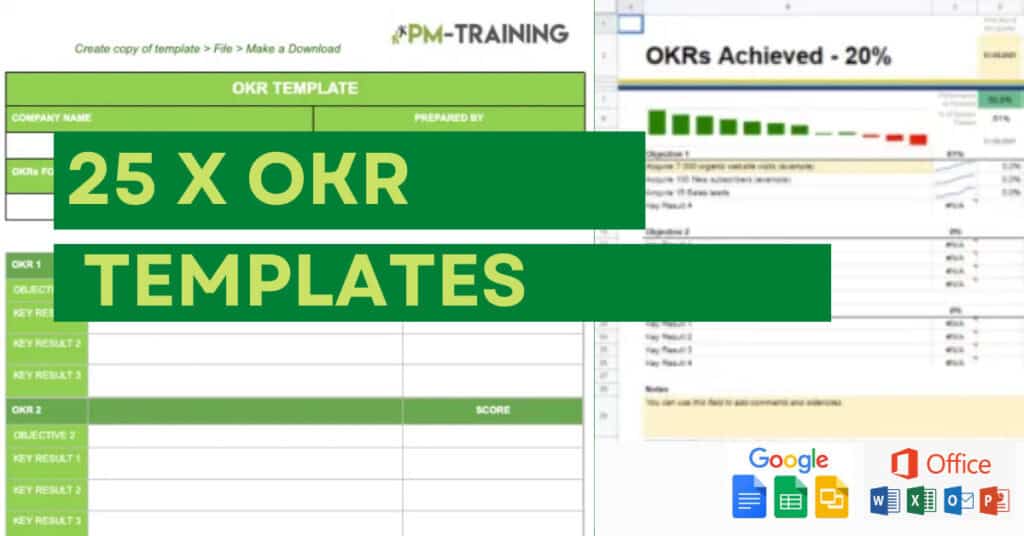
An OKR, or Objectives and Key Results, is a framework for setting measurable goals and tracking progress. It is commonly used in project management and can be adapted to various businesses and organizations. This framework’s goals are meant to be quantitative, hierarchical, and aligned with the company, team, and individual objectives. Also, it can be helpful in keeping projects on track and ensuring that everyone is working towards the same objectives and achieving scalable goals.
An OKR, or Objectives and Key Results, is a tool used in project management to help teams focus on specific goals and measure progress. An OKR typically includes a set of objectives, or goals, that a team wants to achieve, as well as a set of key results, or metrics, that will be used to measure progress.
An OKR tool can be a framework that you can use by organizations to set, track, and measure progress and objectives. When creating one, make sure it is specific, measurable, achievable, relevant, and time-bound. And is constructed with words that are action-oriented and meaningful.
Types of OKR
The type of OKR you use will depend on your company’s needs and goals. There are two types to consider when creating your OKRs:
The Aspirational OKR
An aspirational OKR is a type of goal-setting framework designed to push a company beyond its current capabilities and comfort zone. Unlike standard objectives, aspirational OKRs are intentionally bold, ambitious, and sometimes even slightly out of reach. Their purpose is to inspire innovation, encourage creative problem-solving, and motivate teams to think bigger than their usual targets. By setting these stretch goals, organizations can unlock new opportunities, explore untapped markets, and drive long-term growth that might not be possible with only conservative objectives.
However, while aspirational OKRs are powerful motivators, they must be approached with balance. If goals are set unrealistically high, employees may feel overwhelmed or discouraged, leading to frustration rather than inspiration. To avoid this, companies should clearly communicate that aspirational OKRs are meant to stretch potential, not guarantee 100% achievement. When framed correctly, they can energize teams, foster innovation, and create a culture of continuous improvement.
Committed OKR
A committed OKR is a measurable and realistic goal that teams or individuals pledge to achieve within a defined timeframe. Unlike aspirational OKRs, which are designed to stretch boundaries and inspire innovation, committed OKRs are non-negotiable targets that must be met. They are closely tied to the company’s overall strategy and ensure that day-to-day work directly contributes to broader organizational objectives.
This type of OKR creates accountability across all levels of the business, as it requires clear ownership and consistent tracking of progress. By setting committed OKRs, teams focus on delivering results that are both practical and impactful, reducing ambiguity around priorities. For example, a committed OKR might involve increasing customer retention by 10% in the next quarter or launching a new product feature by a specific deadline. These goals are not optional—they represent the core outcomes that drive business success and align everyone toward a shared mission.
OKR vs KPI
OKRs, or Objectives and Key Results, are best understood as the strategic framework that guides a company’s direction and priorities. They define what an organization, team, or individual wants to achieve and provide a clear roadmap for aligning efforts with broader business goals. Within this framework, KPIs, or Key Performance Indicators, play a complementary role. KPIs are the measurable metrics that track progress toward achieving the objectives outlined in OKRs.
While OKRs focus on the bigger picture—such as increasing market share, improving customer satisfaction, or driving innovation—KPIs break these ambitions into specific, quantifiable measures, like conversion rates, customer retention percentages, or revenue growth. In essence, OKRs set the vision and define success, while KPIs provide the evidence and data to determine whether progress is being made. Together, they create a powerful system for performance management and accountability.
OKR and KPI example
Imagine you are a sales manager, and your primary objective is to increase sales by 20% this quarter. This objective represents your OKR (Objective and Key Result). To track progress toward this goal, you would establish KPIs such as the percentage increase in sales, the number of new deals closed, or the number of calls and meetings completed. These KPIs act as measurable indicators that help you determine whether you are on track to achieve your OKR.
When setting OKRs, it’s important to strike a balance between ambition and focus. Most teams typically establish 3–5 OKRs per quarter, ensuring they remain challenging yet achievable. However, in many cases, having just 1–2 well-defined OKRs can be more effective, as it allows teams to concentrate their energy and resources on the most impactful goals that align with broader business priorities.
How to Write OKR?
Imagine you’re the project leader for a Digital Marketing agency that aims to meet its revenue and more this year. Your team is in charge of optimizing a client’s website funnel in order to generate 10.000 more visitors by the end of the year.
Understand the Components of an OKR
- Objective: This is a clear statement of what your team ultimately wants to achieve. It should be ambitious, inspiring, and directional, giving everyone a shared purpose to align their efforts toward. Think of it as the “what” you are aiming for—a guiding star that sets the tone for your work.
- Key Result: This is the measurable proof that shows whether the Objective has been met. It must be specific, time-bound, and based on concrete facts rather than vague intentions. Key Results turn ambition into accountability by tracking real progress. They outline the “how much” and “by when,” making it clear if the team is succeeding or falling short. Together, Objectives and Key Results drive focus and clarity.
Write the Objective or What Your Organization Wants to Achieve
An Objective defines what your organization is aiming for. It should be ambitious yet realistic, specific, measurable, and aligned with your company’s mission and values. Strong Objectives inspire focus, commitment, and progress toward long-term goals.
- Aspirational OKRs are stretch goals—meant to push the team beyond comfort zones. They’re not always fully achievable, but they drive innovation and growth.
- Committed OKRs are realistic targets your team is expected to deliver. They represent the non-negotiables that ensure business success.
Example Objective: Optimize the marketing funnel to generate 10,000 new leads.
Determine the Key Results
Key Results are the measurable outcomes that show whether your Objective has been achieved. They must be time-bound, specific, and quantifiable—leaving no room for interpretation. Each Key Result should answer the question: “How will we know if we’re successful?” Good Key Results focus on impact, not activity. For example, instead of “send 3 newsletters,” track how many new subscribers or conversions those newsletters generate. This keeps the team accountable to results rather than just tasks.
Examples:
- Grow the email subscribers list from 100 to 350 by December 12th
- Develop 2 marketing campaigns by December 1st
- Test current nurture streams by November 30th
Plan Your Initiatives
Initiatives are the concrete actions and projects you’ll execute to hit your Key Results. They answer the “how” behind the OKRs. While Key Results define the finish line, Initiatives map the path to get there. Think of them as the strategies, experiments, or campaigns that drive measurable outcomes. For instance, if your Key Result is to grow email subscribers, initiatives might include launching a lead magnet, running a social ad campaign, or improving sign-up forms.
Final Output Example
Objective (O): Optimize a marketing funnel to generate 10,000 new leads.
Key Results (KR):
- KR 1: Grow the email subscribers list from 100 to 350 by December 12th
- KR 2: Develop 2 marketing campaigns by December 1st
- KR 3: Test current nurture streams by November 30th
Initiatives:
- Audit and update existing email nurture sequences for higher engagement
- Launch a downloadable lead magnet (eBook or checklist) to capture new sign-ups
- Run targeted Facebook and LinkedIn ad campaigns promoting the funnel
OKR Template Google Docs
We have created the below OKR template on Google Docs. You can create your own copy here.
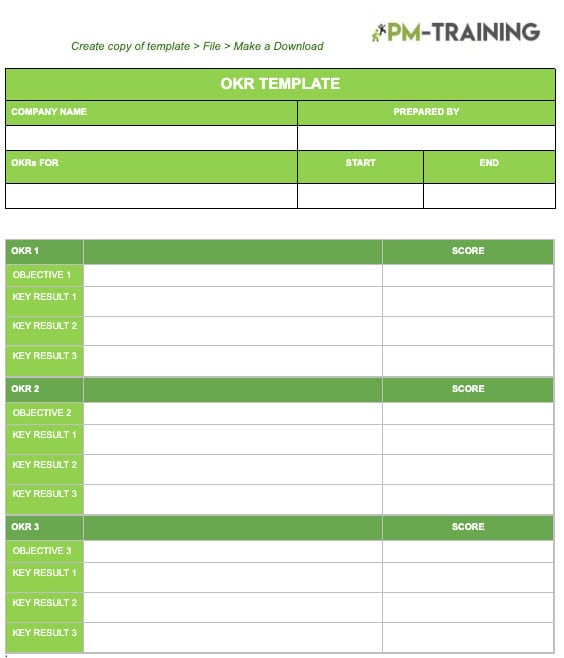
OKR Planning Template Word
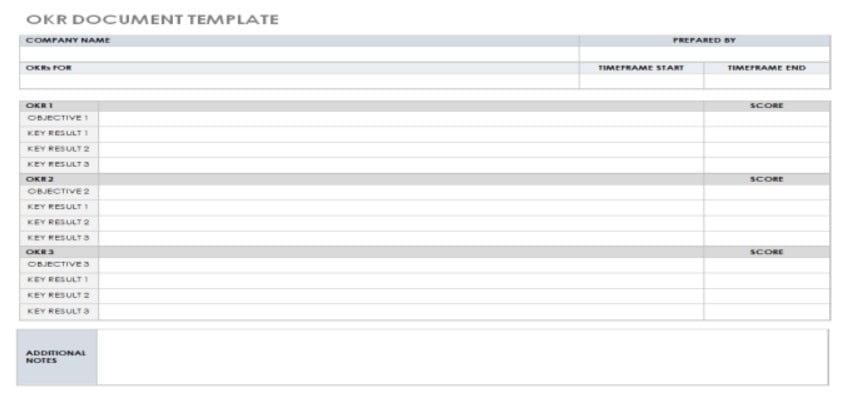
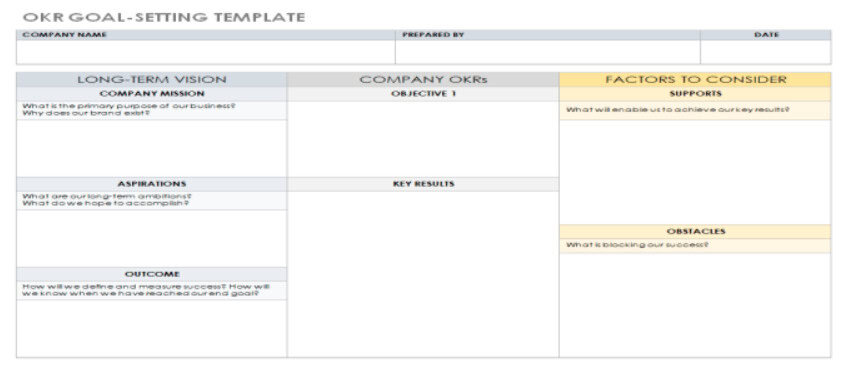
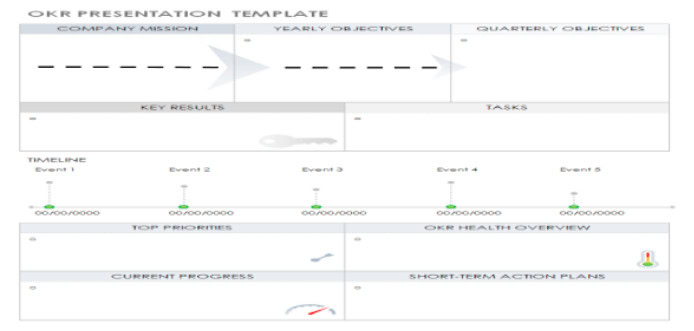
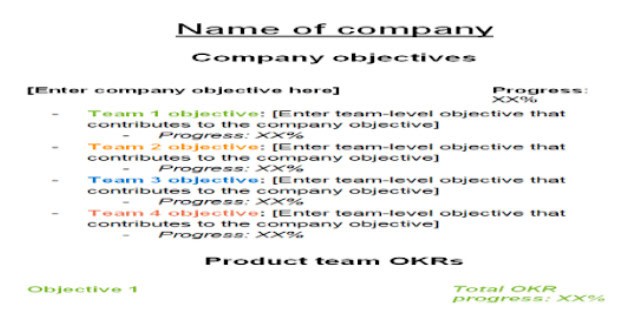
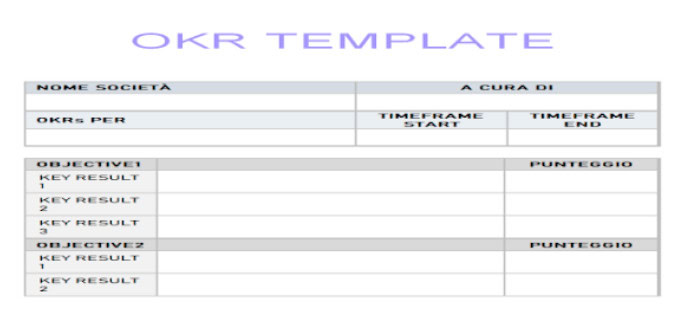
OKR Planning Template Excel
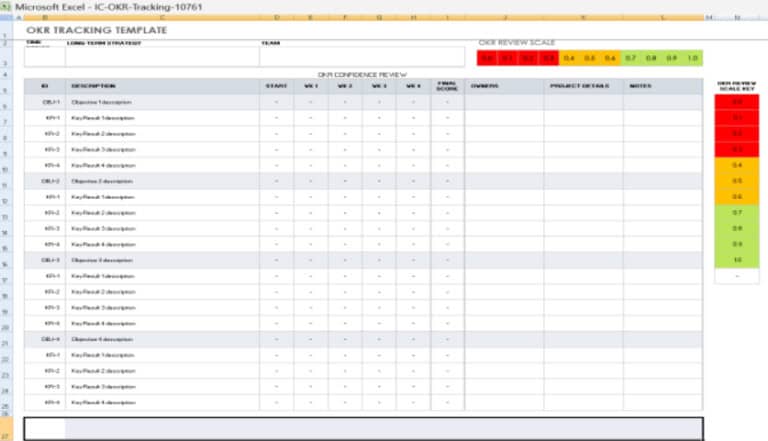

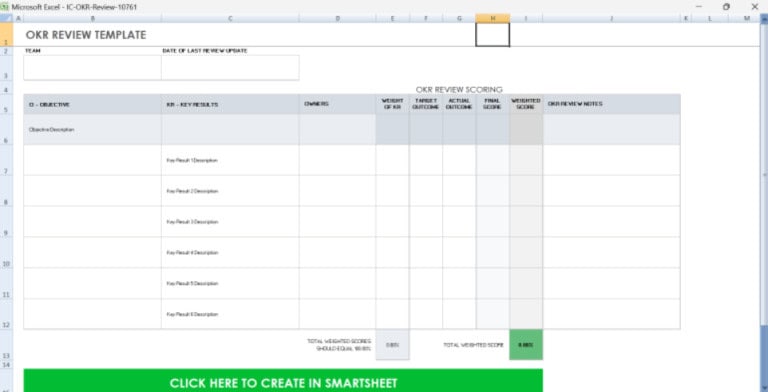
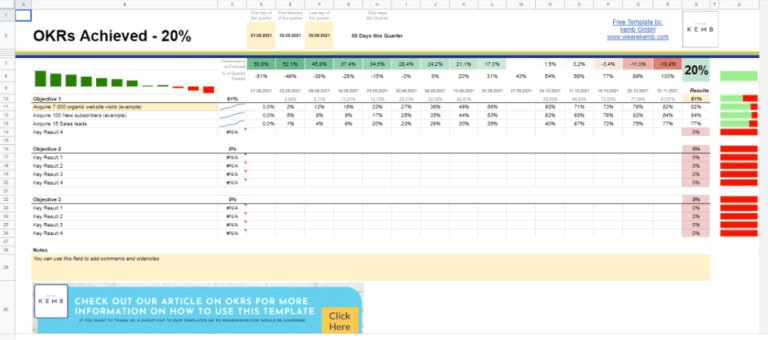
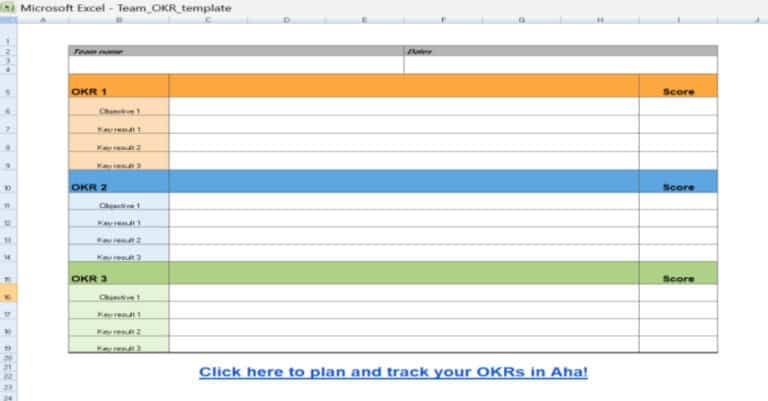
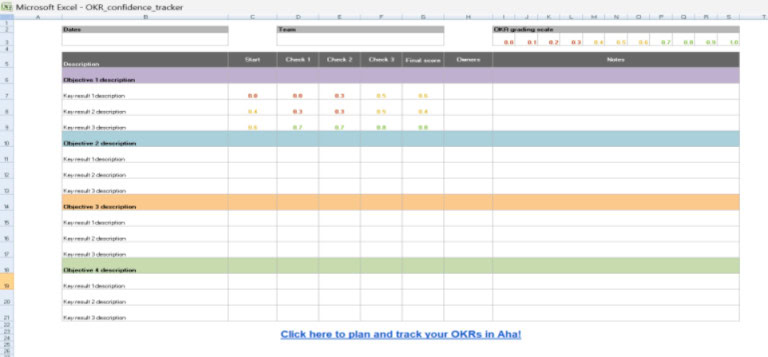
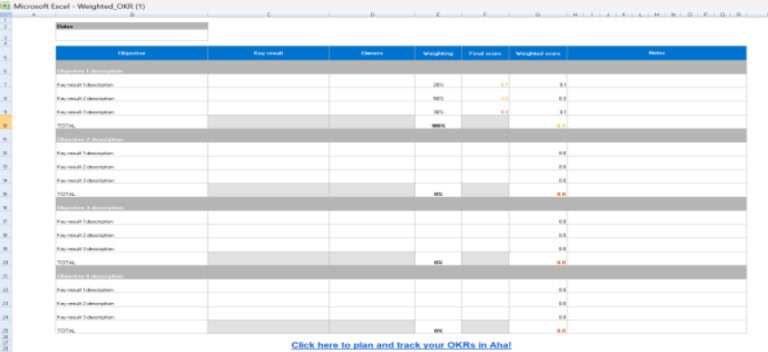
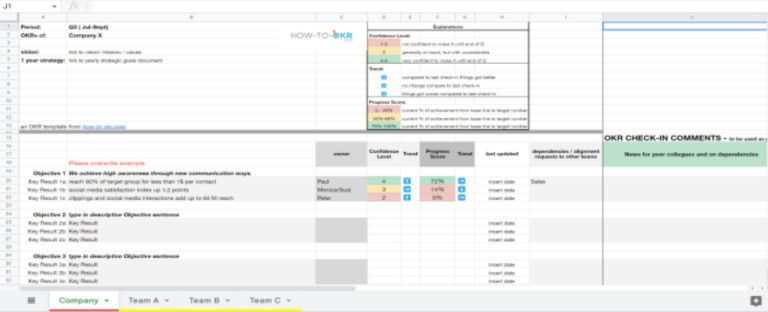
OKR Planning Template PowerPoint
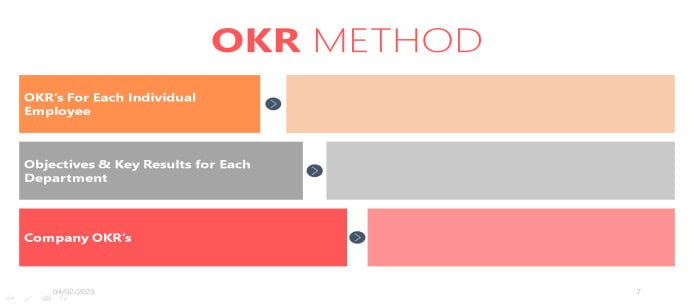
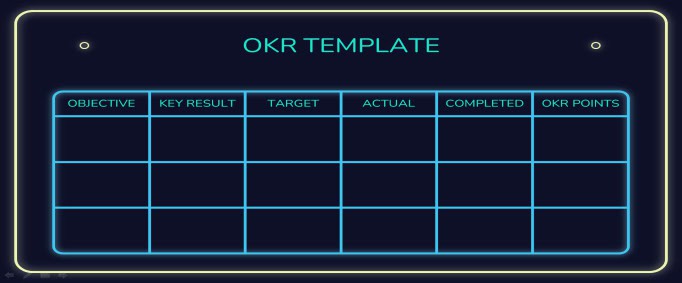
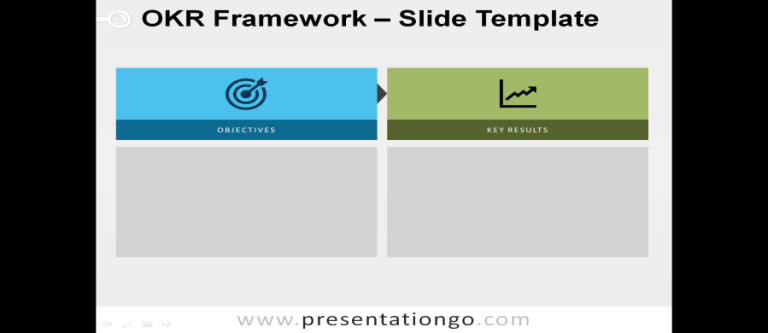

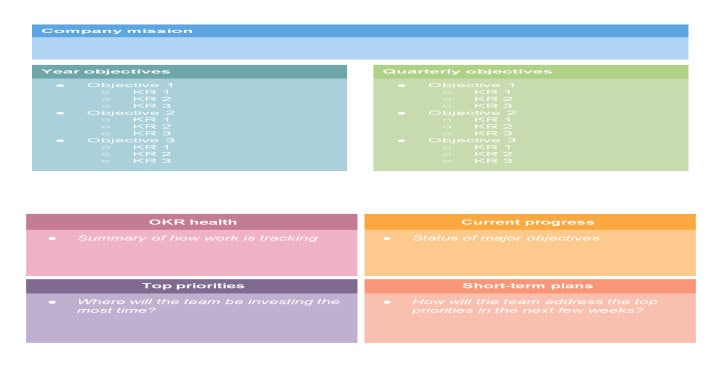
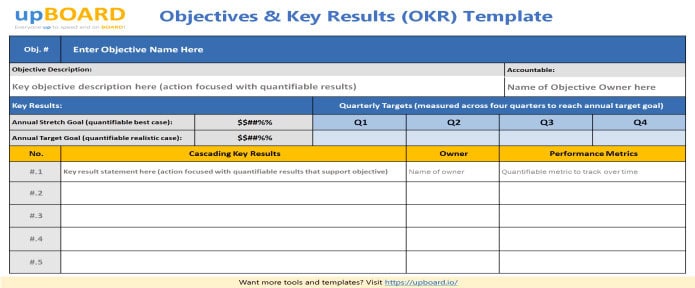
Online Tools for OKR Planning
Asana
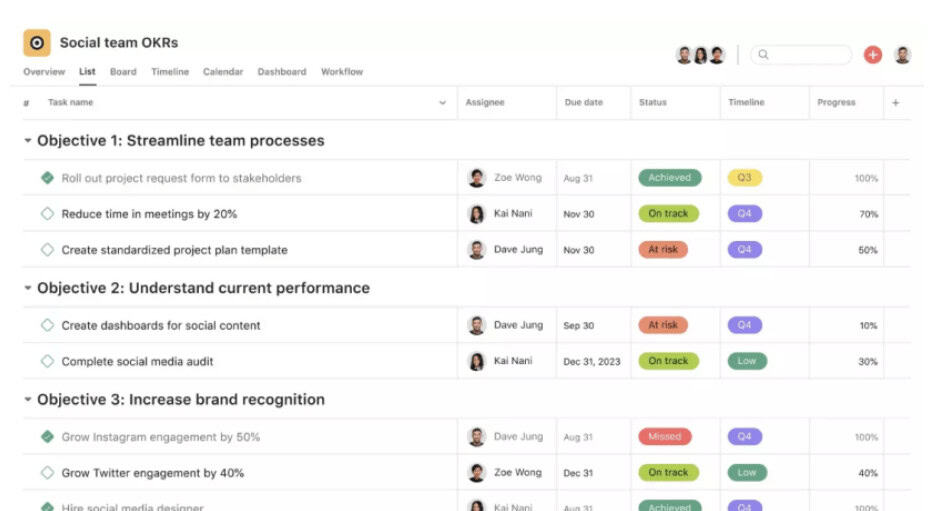
The Asana OKR management app helps you achieve goals by using its planning features. It helps understand the relationship between daily operations and top goals.
ClickUp
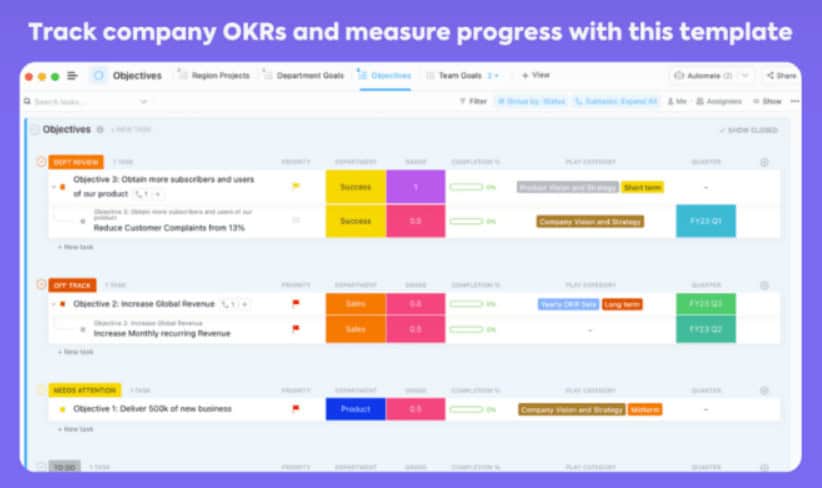
ClickUp is an OKR and productivity tool for teams in small and large companies. From managing remote teams to advanced performance management, it’s the right software for performance management. ClickUp helps align business operations with objectives.
Trello
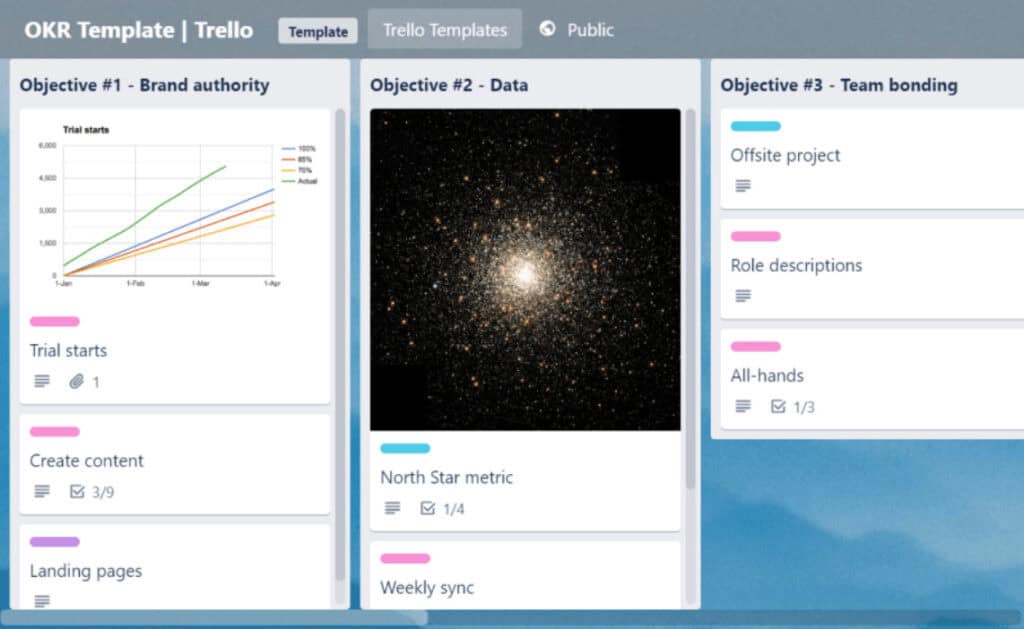
The Trello goal-setting OKR system is a great tool to increase the productivity of your team. There’s a lot that can be dug into but the Trello OKR Planning basics are enough to keep you moving forward to achieve your project goals.
Miro
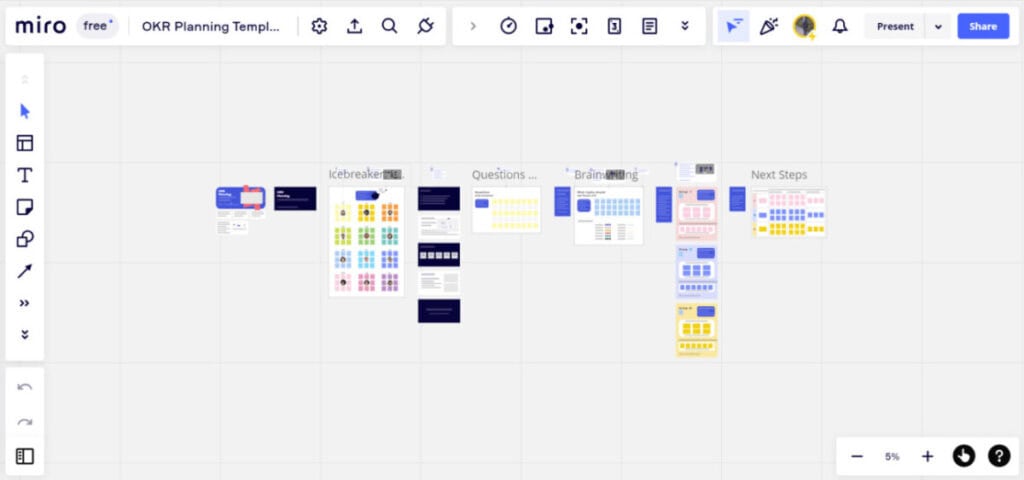
Use the Miro OKR Planning template to organize the process from end to end, allowing you to define your company and team OKRs. Take the knowledge of your audience into consideration when you plan an OKR session.
Wrike
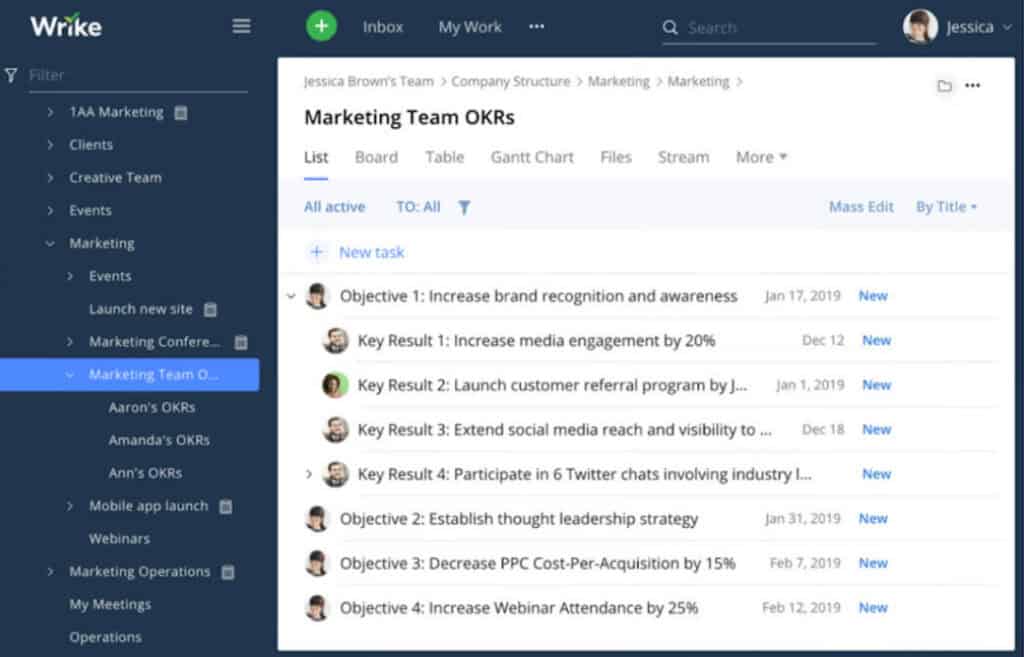
Wrike gives the project manager and the project team the ability to see goals that match the vision of the company. The Wrike OKR Template helps teams with goals that align with and help build ambitious and overarching objectives.
How to Create an Effective and Strategic OKR
- Set specific, measurable, achievable, relevant, and time-bound objectives, that is to say SMART goals
- Make sure your objectives are aligned with your company’s strategy.
- Choose a few key results that you will use to measure progress towards your objectives.
- Set a timeframe for your OKR.
- Assign responsibility for each key result.
- Review and adjust your OKR periodically.
Mistakes to Avoid When Writing an OKR
There are a few common mistakes that people make when creating OKRs. Here are a few of them:
- One common mistake is setting goals that are too small or too easily achievable. This can lead to a feeling of dissatisfaction among employees when they reach the goal, as it was not truly challenging.
- Another common mistake is setting goals that are too large or unrealistic. This can lead to frustration and a sense of failure, as the goal feels unattainable.
- Not involving all members of the team in the goal-setting process.
- Not having a timeframe for each objective.
- Not revisiting and adjusting objectives as needed.
Useful Online Tools When Creating OKR
If you are thinking of adopting OKR management software for your organization, here’s a list of the most popular platforms you can find online:

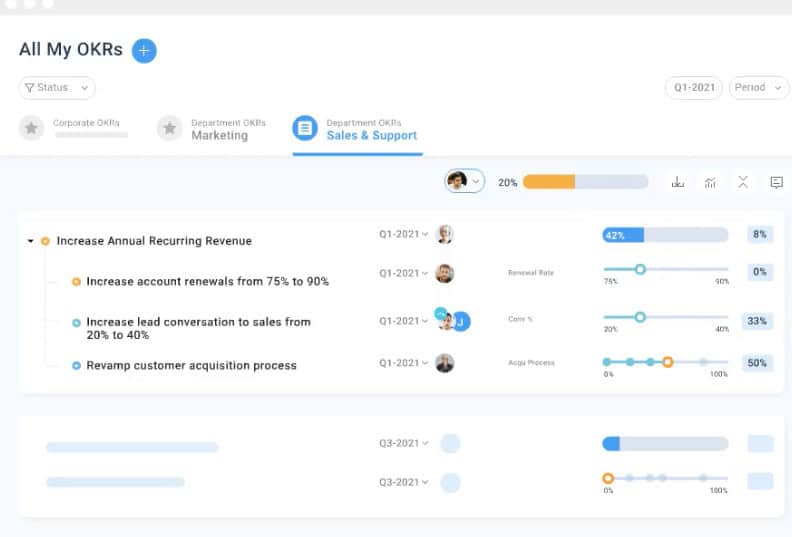
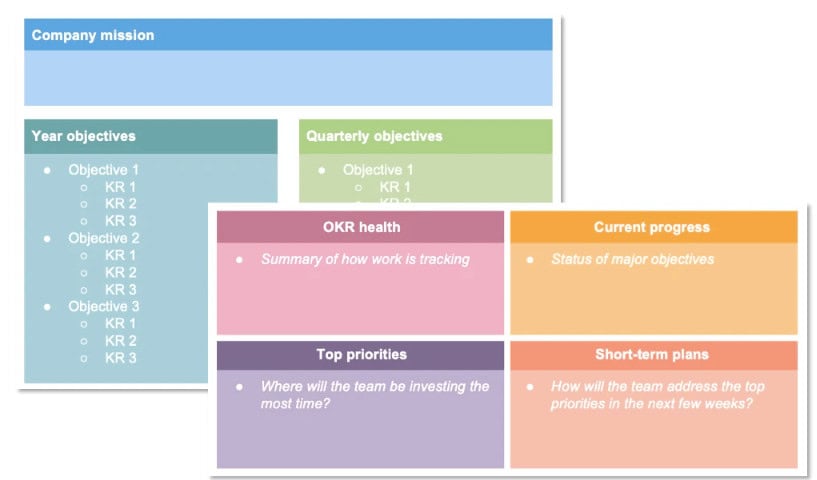
What Makes a Good OKR
When creating OKRs, it’s important to ensure they are SMART: Specific, Measurable, Achievable, Relevant, and Time-bound. This framework guarantees that your goals are clear, realistic, and trackable. A well-defined OKR not only sets direction but also provides a measurable path to success. Equally important is involving your team in the process. Collaboration ensures alignment, fosters ownership, and increases commitment to achieving the objectives. When everyone contributes to shaping the OKR, it creates a shared sense of responsibility and motivation.
Another key practice is to review and adjust your OKRs regularly. Circumstances change, and your goals should remain flexible enough to stay relevant while still challenging. As a best practice, aim to create two to three Key Results per Objective. This keeps focus sharp without overwhelming the team. Finally, link your OKRs directly to your project plan for easy tracking and seamless execution.
FAQs
What is an OKR?
OKR means Objectives and Key Results—a structured goal-setting framework. Objectives define what you want to achieve, while Key Results measure progress with specific, time-bound metrics. Together, they drive clarity, focus, and alignment across teams and organizations.
What makes a good OKR?
A strong OKR is simple, specific, and measurable. The Objective should be ambitious yet clear, while the Key Results must be time-bound, quantifiable, and outcome-focused. Good OKRs eliminate confusion, ensuring every team member understands success and how it’s measured.
What are the benefits of using OKR?
OKRs create clarity of purpose, aligning individual and team efforts with organizational goals. They encourage accountability, sharpen focus, and improve execution by measuring results. Teams using OKRs can prioritize effectively, adjust quickly, and ensure resources support what truly matters most.
Why does OKR fail sometimes?
OKRs fail when organizations set too many, make them vague, or misalign them with strategy. Unrealistic expectations, poor communication, and weak leadership buy-in also derail progress. Success requires discipline, prioritization, and ongoing commitment from leadership and every team member.
Are OKRs considered to be Agile?
Yes. OKRs complement Agile by enabling teams to set clear goals, measure progress, and adjust based on results. They reinforce iteration, transparency, and accountability, ensuring efforts remain focused, adaptable, and aligned with evolving priorities throughout project or sprint cycles.
Suggested articles:
- 11 x Executive Project Status Report Template – Word, Excel
- 33 x Agile Status Report Templates Word, Excel, Google
- 7 X Free Cost Plus Contract Templates Google Docs & PDF
Shane Drumm, holding certifications in PMP®, PMI-ACP®, CSM, and LPM, is the author behind numerous articles featured here. Hailing from County Cork, Ireland, his expertise lies in implementing Agile methodologies with geographically dispersed teams for software development projects. In his leisure, he dedicates time to web development and Ironman triathlon training. Find out more about Shane on shanedrumm.com and please reach out and connect with Shane on LinkedIn.